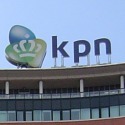The Dutch incumbent has seen a fall in maintenance costs and improvement in customer spending in areas where fiber has been deployed.

"We're fiber lovers," proclaims Babak Fouladi, jokingly upset that he was introduced at this week's Broadband World Forum as CTO and not CDO (chief digital officer) of KPN, the Dutch incumbent. Love is not the word many of his peers would honestly use to describe their relationship with fiber. Compelled to invest by rivals and regulators, they have seen costs escalate while sales remain flat. But Fouladi's affair with the high-speed technology has at least brought some payoff.
In a country of about 8 million households, KPN now covers about 3 million with its full-fiber network, partly through a joint venture called Glaspoort with APG, a pension provider. It is targeting 80% population coverage by the end of 2026 and currently adding about 10,000 premises to its fiber footprint each week. Even in combination KPN's rivals "will not match what we are rolling out today," boasts Fouladi.
But his project carries a substantial cost. KPN pumped about €625 million (US$726 million) into capital expenditure in the first six months of 2021, a 9.2% year-on-year increase. As a percentage of revenues, spending was up from 21.8% to 24.2% over that period. And operational free cash flow sank nearly a tenth, to €531 million ($616 million). It was thanks only to cash restructuring and lower interest payments that KPN managed to boost free cash flow by 17%, to €301 million ($349 million).
Figure 1:  KPN CTO Babak Fouladi: 'We're fiber lovers.'
KPN CTO Babak Fouladi: 'We're fiber lovers.'
A stubborn refusal to invest would be much costlier, though. "We have never been more important than now," says Fouladi, reflecting on lessons learnt during the pandemic, when data traffic soared on KPN's network. "What we build is going to be very important for enabling a digital society." Shirk that responsibility and customers may quickly disappear.
In the meantime, Fouladi can point to some encouraging metrics about the fiber rollout. Shifting from copper to fiber has, for one thing, led to a sharp drop in maintenance costs of about 67% in areas where the high-speed technology is now available. Churn, a measure of customer defections, is also down 40%, proving that KPN's subscriber base would rapidly shrivel if it was not deploying fiber.
Moreover, customers that have upgraded from copper to fiber appear to be spending more themselves. "ARPU [average revenue per user] is increasing every time we change a copper to a fiber customer," says Fouladi. His data points shows that ARPU for a fiber customer is 8.6% higher, at about €54 per month. "The fiber business case stands on its own," he says.
Retirement program
In tandem with all this, KPN has been switching off older technologies and retiring dusty IT platforms to save money. "This year we shut down 65 different apps," says Fouladi. "The strategy before was to create a layer on top, but the legacy underneath wasn't shut down. We combined a shutdown of that with cloudification of the IT stack and have started moving to cloud-native apps." He is also dispensing with many of the data centers that KPN used to operate, reducing the number from 30 to just four.
There have been some hard knocks for staff. Back in 2014, KPN employed as many as 18,000 people. By June this year, the number had fallen to just 9,805, according to the latest financial statements. Earlier divestment activity explains most of the cuts, but they have more recently been attributed to KPN's "simplification and digitalization program."
Want to know more about 5G? Check out our dedicated 5G content channel here on Light Reading.
There is optimism that KPN will not have to repeat the broadband-investment exercise anytime soon. It has based its rollout on a mixture of GPON and XGS-PON technologies supplied by Nokia. While the former satisfies immediate needs, the latter is a 10-gigabit system that should be able to cope with rising usage of more advanced applications for years.
Today, it is mainly used to address business customers. KPN has also been connecting its mobile sites to XGS-PON links for "backhaul," the important link to the core network. When Light Reading spoke with Fouladi in March this year, 90% of mobile sites had already been "fiberized" with these 10-gigabit links, he said.
The subsequent step, perhaps a decade from now, will be 25G PON, an even higher-speed technology. It is backed by Nokia over the Huawei-endorsed 50G PON as the next big industry transition. By then, the hard job of digging up streets to lay fiber-optic cables should be done. And KPN's prospects in a full-fiber world will be clear.
Related posts:
— Iain Morris, International Editor, Light Reading
Read more about:
EuropeAbout the Author(s)
You May Also Like











